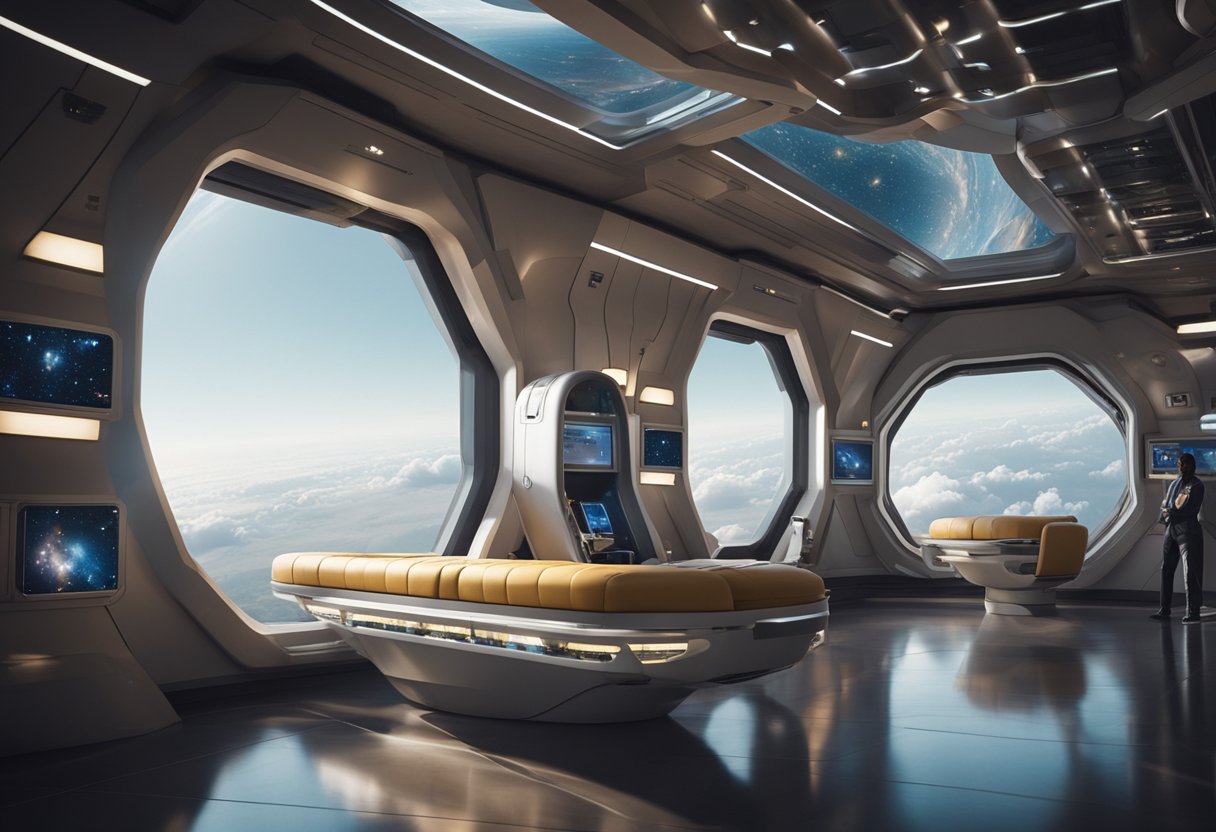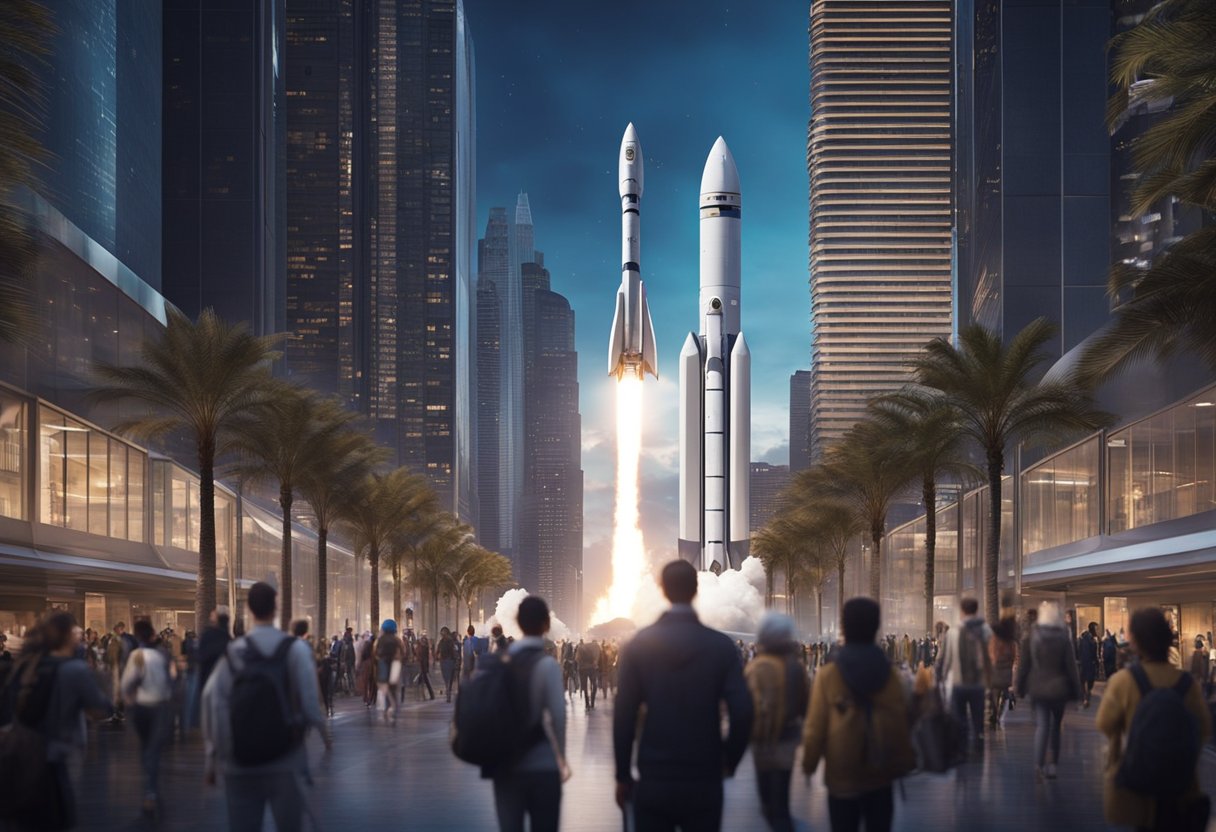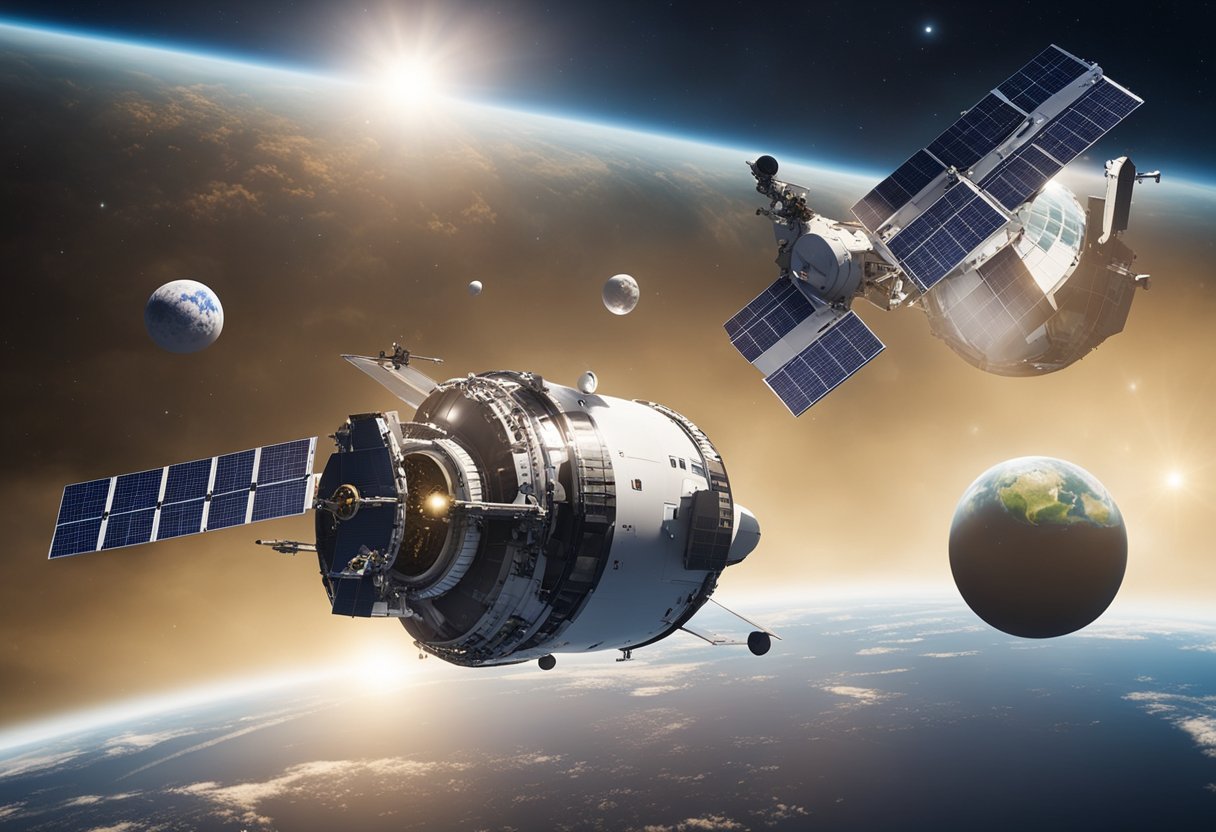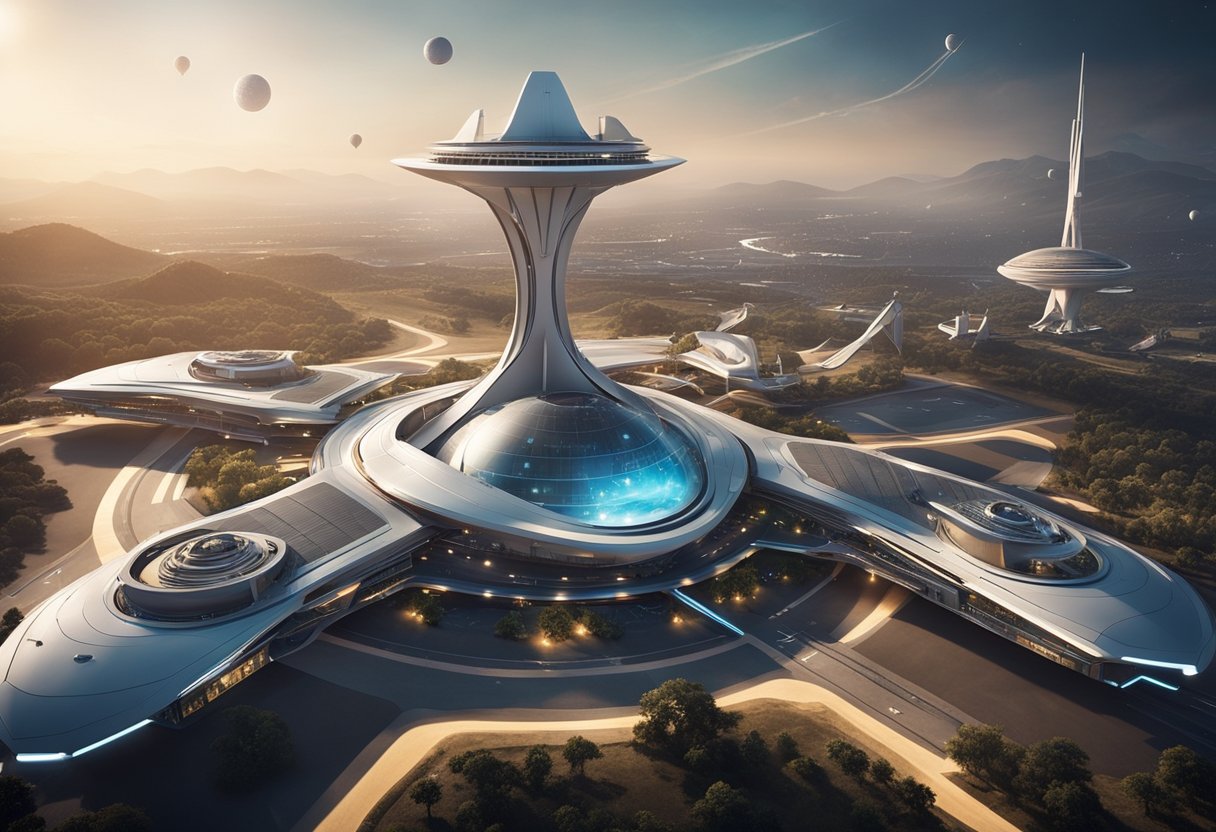
As we peer into the future, space tourism emerges not just as a possibility, but as an imminent reality. Advances in technology and a growing interest from the public have set the stage for an era where the cosmos becomes the next frontier for leisure travel. Space tourism is developing at a remarkable pace, promising to make the experience of leaving Earth’s atmosphere accessible to more than just astronauts.

Thanks to pioneering companies and enterprising startups, potential destinations for space tourists are expanding. SpaceVoyageVentures.com is a testament to this burgeoning industry, offering a glimpse into a future where trips beyond our atmosphere may become as routine as flights to exotic destinations on Earth. The website stands as an early resource for those curious about space travel, presenting a catalogue of trips currently available and others on the horizon.

In this section, we’ll explore pivotal developments that have shaped space tourism, from the inception of private space firms to the intrepid individuals who have journeyed beyond our atmosphere.
The space race of the mid-20th century, initially a competition between national governments, set the stage for today’s private space endeavours. Following the era where NASA and its Soviet counterparts dominated space exploration, we’ve witnessed the emergence of private companies that aim to make space travel accessible to non-astronauts. Two notable figures, Richard Branson and Jeff Bezos, have been instrumental in propelling the commercial spaceflight industry forward.
Branson’s Virgin Galactic and Bezos’ Blue Origin are at the forefront of suborbital space tourism, offering brief but groundbreaking journeys to the edge of space. These milestones not only leverage technology to reach new heights but also spark the collective imagination about what space travel could become. On SpaceVoyageVentures.com, enthusiasts can delve into the burgeoning realm of space tourism, including trips that are one step away from becoming a reality.
Our journey to the stars is punctuated by the daring feats of a select few individuals. Alan Shepard’s bravery during the earliest days of manned spaceflight paved the way for private citizens eager to gaze upon the Earth from above. Fast forward to the 21st century, and we see figures like Jared Isaacman embodying the spirit of adventure through privately-funded space missions.
Isaacman, a businessman and pilot, led the Inspiration4 mission, which marked a significant step in space tourism by being the first all-civilian crew to orbit Earth. Such missions are not only historical achievements but also critical tests for space tourism’s viability and safety. These remarkable journeys are meticulously documented on platforms like SpaceVoyageVentures.com, highlighting the transition from an exclusive scientific realm to a new frontier for exploration accessible to a broader population.

In this section, we’ll take a closer look at the innovators and industry leaders paving the way for a new frontier where space travel transforms from science fiction into reality.
SpaceX, founded by Elon Musk, has become synonymous with space innovation and its goal to make space travel more accessible. With a history of partnerships with NASA and other entities in space exploration, SpaceX’s contributions to space tourism are anchored by their Crew Dragon spacecraft, which has already begun ferrying astronauts to the International Space Station (ISS).
Virgin Galactic, spearheaded by Sir Richard Branson, promises a suborbital experience with their SpaceShipTwo, a craft designed for a unique astronaut experience. These zero-gravity flights offer a glimpse of space, with the company pacing towards a full commercial launch, inviting non-professional astronauts to witness Earth from above.
Led by Jeff Bezos, Blue Origin sets its sight on suborbital and orbital human spaceflight. New Shepard, their reusable rocket, is aimed at providing passengers with a few minutes in weightlessness and a stunning view of the planet, marking its own territory in the burgeoning market of space tourism.
The Russian space agency, Roscosmos, has been a long-standing participant in space, offering Soyuz spacecrafts for trips to the ISS. Alongside, other international firms and agencies collaborate and innovate, broadening the scope for tourism beyond Earth’s atmosphere. Boeing, a key player in aerospace, continues to develop its Starliner capsule, contributing to the diverse offering in the space tourism sector.
For further insights into potential future ventures in space, SpaceVoyageVentures.com is an early adopter in documenting the emerging market of space tourism, from current excursions to visions of what’s nearing readiness for the public.

The advancement of technologies has considerably lowered the barriers to space travel, marking the beginning of a new era for commercial space tourism. Innovative spacecraft designs and the development of reusable rocket technology have been pivotal in this paradigm shift.
We are witnessing a leap in spacecraft design aimed at supporting commercial space travel. Notably, the Dragon spacecraft, developed by SpaceX, represents a significant milestone. Its Crew Dragon spacecraft, a variant tailored for transporting astronauts, signals SpaceX’s commitment to safety and comfort for space travellers. Similarly, the Soyuz spacecraft has a long history of orbital functionality and has adapted over time to cater to commercial voyages to the International Space Station (ISS).
SpaceX’s Starship stands as a beacon of innovation aimed at lunar missions and eventually Martian expeditions. Its proposed design promises not just to carry astronauts, but also to increase the accessibility of space for the general public. These spacecraft are the cornerstone of future space tourism, presenting the general public with tantalising glimpses of orbital travel experiences.
The push towards reusable rockets has redefined space missions dramatically. We’ve seen this with the introduction of rockets designed to safely return to Earth for refurbishment and re-flight, rendering space travel more economically sustainable. This development is a fundamental driver behind the lowering costs we now associate with space tourism, thus enabling a more regular and accessible spacefaring future.
Recognising the essence of this technological evolution, companies such as SpaceX have made considerable strides with their reusable rockets. The implementation of such technology in their Falcon and Starship rockets is paving the way for potential tourist trips to orbit and beyond.
SpaceVoyageVentures.com highlights the increasing accessibility and viability of space tourism ventures, owing in large part to these ground-breaking technological achievements within the aerospace sector. Our gradual progression into a realm where space travel is more commonplace hinges on these ongoing advancements.
Space tourism promises significant financial growth for the economy and could serve as a catalyst for advancements in STEM education and research.
Experts project that the space tourism market is poised for robust expansion, with an estimated value potentially exceeding $800 billion by 2030. This growth is not just hypothetical; private space companies are already facilitating suborbital flights and plotting out future orbital experiences. For instance, reports from Morgan Stanley Research have highlighted the momentum building in this sector, detailing the economic potential. Furthermore, initiatives like SpaceVoyageVentures.com showcase the burgeoning market by chronicling current and imminent space travel opportunities, indicating the sector’s readiness for consumer engagement.
The rise of space tourism is intricately linked with STEM – science, technology, engineering, and mathematics. Our continued investment and interest can have a considerable ripple effect on education and research. The excitement surrounding the prospect of touring space ignites passion in individuals, prompting an increased interest in STEM subjects. This, in turn, boosts research and pushes the boundaries of what is possible. For example, the successful test flight by Virgin Galactic has not only marked a significant milestone but has also reverberated through educational institutes, encouraging students to pursue careers in this revolutionary field.
Exploration has always been at the core of human ambition, and today we stand on the brink of a new frontier—space tourism. Major advancements are paving the way for travel beyond Earth, with several potential destinations already on the itinerary for adventurous tourists.
Our first noteworthy destination is the International Space Station (ISS), which has been orbiting Earth since 1998. Currently facilitating research and international cooperation, the ISS is also a precursor to more ambitious orbiting space hotels. For instance, Axiom Space plans to launch a space station by 2024, heralding a new era where space tourism extends to luxurious accommodations in orbit.
Our gaze naturally shifts to our celestial neighbour, the Moon, an object of human fascination for millennia. The Moon presents a tangible goal for short-term stays and is a significant milestone for our off-world endeavours. Meanwhile, Mars represents the zenith of our spacefaring aspirations. A journey to Mars would signify one of the greatest accomplishments in the history of exploration, with efforts well underway to transform this objective into reality, as chronicled on SpaceVoyageVentures.com. Our ventures to the Moon and Mars are more than mere dreams; they signify our unwavering commitment to go where none have before.

As we embark on the journey to becoming space tourists, there are essential aspects to consider regarding our preparation for the experience and how we’ll adapt to the new environment of space.
Before we ascend beyond the Kármán line, we undergo rigorous training designed to prepare us for the voyage. This training includes familiarisation with the spacecraft, safety procedures, and dealing with the physical demands of launch and re-entry. Astronauts have traditionally trained for years, but as space tourists, we’re required to complete a condensed version of this training to ensure we are ready for the journey ahead.
In the unique environment of space, we will experience weightlessness. This sensation, also known as zero gravity, is akin to continuous free-fall. It offers a novel experience where we can float freely within the spacecraft. Our time in orbit is spent not just marvelling at the view but also adapting to zero-gravity living, from eating and sleeping to the way we move. It necessitates a different approach to everyday tasks, which is both exhilarating and challenging.

As we enter a new era of space exploration, with human spaceflight transitioning from governmental agencies to private companies, there are critical regulatory and safety challenges that must be addressed. A comprehensive regulatory framework is crucial for ensuring the highest standards of safety and legality.
Space tourism is an evolving sector that demands explicit legal frameworks to manage its operations effectively. The Outer Space Treaty, as the foundational international space law, provides a general guideline for the peaceful exploration and use of outer space. The establishment and enforcement of these regulations is vital for protecting the rights and responsibilities of space tourists and industry operators. Recently, discussions have included how to adapt space law to accommodate the safety of space travellers, considering that the majority of current legislation was crafted for state-sponsored programs rather than private space endeavours. The Congressional Research Service highlights the importance of a stricter regulatory regime for this burgeoning sector.
In addition to legal considerations, the technological advancements in passenger safety are paramount. Our collective experience with space missions informs us that the reliable operation of spacecraft requires rigorous testing, failsafe systems, and backup protocols. Companies such as those featured on SpaceVoyageVentures.com are pioneering these safety measures. With a focus on safety, organisations are developing and improving features such as life-support systems, re-entry protection, and emergency escape mechanisms to ensure that human spaceflight can be carried out with the utmost regard for passenger welfare.

As we examine the burgeoning industry of space tourism, it is essential that we address the environmental implications associated with extraterrestrial travel. Our focus lies in understanding the potential impacts on climate change and the necessity for sustainable practices.
The rise in space tourism brings forth potential risks to our planet’s climate. Rocket launches emit particles and gases into the atmosphere that could have significant effects on the ozone layer and climate. Our concern is centred on how the increase in these emissions from frequent space flights might exacerbate climate change. Environmental professionals are examining the cumulative impact of rocket launches, weighing the environmental costs against the benefits of outer space exploration.
We recognise the importance of implementing sustainable practices in space travel to mitigate any negative environmental impacts. Strategies include utilising more eco-friendly rocket fuels and designing spacecraft that are reusable, aims to reduce both carbon footprint and space debris. With websites like SpaceVoyageVentures.com documenting current and future space tourism opportunities, there is an emergent need for the space industry to adopt these sustainable methods uniformly to preserve our planet’s climate. It is not enough to explore new horizons; we must ensure that we do so responsibly.

In the realm of space tourism, the democratization of access represents a pivotal shift. As private companies innovate, we witness a steady move towards opening space up for more than just the wealthiest explorers.
We’ve observed a consistent effort to bring down the costs associated with travelling beyond the Kármán line – the defined edge of space. This is fundamental for enabling private citizens to participate in space tourism. Through advancements in rocket reusability and fuel efficiency, entities like SpaceX and Virgin Galactic are carving out opportunities for a more economy-friendly space experience. This initiative addresses one of the most significant barriers, ensuring that future vacations among the stars aren’t just a privilege for the elite few.
Public-private partnerships have proven to be a crucial ingredient in enhancing space tourism accessibility. By collaborating, governmental space agencies and private firms can spread the substantial costs and share risks. This synergy not only boosts innovation but also enhances the safety and feasibility of bringing more individuals to space. We are seeing numerous examples where these partnerships have supported developmental milestones, reinforcing our belief in the potential expansion of space tourism to a broader audience.
By focusing on these key aspects, we are contributing to a burgeoning market that promises to transform the economy and shatter records as more private citizens look to the heavens for their next adventure. For those keen on following these developments closely, SpaceVoyageVentures.com stands as a testament to this golden era of space exploration – a beacon for what’s currently possible and a glimpse into a not-so-distant future.
The evolvement of space tourism relies significantly on advancements in space habitats, which offer a unique blend of comfort and functionality for travellers in the cosmos.
Space hotels and habitats present an innovative concept aimed at turning space travel into a reality for those beyond astronauts. At the forefront are visionary entities like Space Perspective that aspire to craft serene experiences for passengers using their Spaceship Neptune, a balloon-assisted capsule designed for leisurely ascents into the stratosphere. Paramount in these ventures is the development of modules that can sustain life in the void of space, integrating necessities such as life support, radiation protection, and amenities superior to those on traditional spacecraft. SpaceVoyageVentures.com offers a glimpse into these nascent experiences, charting paths for travellers eager to witness Earth from above.
Axiom Space stands out as a pioneering force, working towards the assembly of the world’s first commercial space station. Their plan is methodically structured, beginning with modules attached to the International Space Station (ISS) and eventually forming a free-flying habitat. Here, private astronauts and researchers can partake in orbital stays. With the conception of the space hotel, Axiom strives to curate a novel orbital destination, promoting research and leisure in unprecedented synergy. Our commitment to this realm lies in promoting sustainable and comfortable environments conducive to extended periods of time spent off-planet.

Before diving into the specifics of public perception and media representation, it’s essential to understand that the image of space tourism is greatly influenced by how it is portrayed by various media outlets and how this portrayal shapes public opinion.
Media has a profound impact on the public’s enthusiasm for space tourism. Coverage ranges from science fiction films, which often inspire a sense of wonder and possibility, to news articles dissecting the technological advances and business ventures of companies like SpaceX. This coverage can have a direct effect on public support for space initiatives. For instance, our research indicates that when media outlets share the ambitions of companies aiming to provide experiences like the Axiom Mission 1, public interest in these ventures tends to rise. Similarly, TV coverage about Spaceship Neptune, a proposed high-altitude balloon trip to the edge of space, piques the curiosity of potential space tourists and the general populace alike.
Documenting space tourism is paramount for educating and enticing future space tourists. Currently, SpaceVoyageVentures.com offers insights into various missions and the experiences of crew members and tourists who venture beyond our atmosphere. With every detailed article about a space tourist’s journey or a crew member’s account of the awe-inspiring sights from space, public perception shifts and becomes more informed. This contributes to a growing interest in ventures like Spaceship Neptune, which promises incredible views of Earth from the cusp of space, allowing individuals to imagine themselves as future participants in these extraordinary journeys.

In this section, we’re addressing some of the most common enquiries regarding the anticipated developments and considerations in the field of space tourism.
The cost of space tourism is expected to vary greatly in the initial stages, depending on the duration and the type of experience offered. Reduction in prices over time is hoped for as technology advances and commercial operations scale up.
Companies like SpaceX, Blue Origin, and Virgin Galactic are pioneering the space tourism industry, each offering different forms of space travel experiences, from suborbital flights to potential orbital hotels.
Space exploration is likely to further integrate with commercial interests, leading to enhanced technologies for lunar and Martian exploration, and potentially harvesting resources from asteroids and other celestial bodies.
The benefits include stimulating technology advancements, creating new industries, and providing unique experiences. Conversely, drawbacks involve the environmental impacts of increased launches and the sustainability of long-term operations.
Space vacations will become more widely accessible once the cost lowers through mass participation and technological refinements. This could take several years to decades as the industry matures.
There are ambitious plans to expand space tourism to include lunar bases and Martian outposts as destinations. This would be the result of long-term international cooperation and technological innovation.